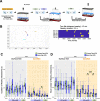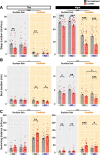Metabolic shift toward ketosis in asocial cavefish increases social-like affinity
- PMID: 37840141
- PMCID: PMC10577988
- DOI: 10.1186/s12915-023-01725-9
Metabolic shift toward ketosis in asocial cavefish increases social-like affinity
Abstract
Background: Social affinity and collective behavior are nearly ubiquitous in the animal kingdom, but many lineages feature evolutionarily asocial species. These solitary species may have evolved to conserve energy in food-sparse environments. However, the mechanism by which metabolic shifts regulate social affinity is not well investigated.
Results: In this study, we used the Mexican tetra (Astyanax mexicanus), which features riverine sighted surface (surface fish) and cave-dwelling populations (cavefish), to address the impact of metabolic shifts on asociality and other cave-associated behaviors in cavefish, including repetitive turning, sleeplessness, swimming longer distances, and enhanced foraging behavior. After 1 month of ketosis-inducing ketogenic diet feeding, asocial cavefish exhibited significantly higher social affinity, whereas social affinity regressed in cavefish fed the standard diet. The ketogenic diet also reduced repetitive turning and swimming in cavefish. No major behavioral shifts were found regarding sleeplessness and foraging behavior, suggesting that other evolved behaviors are not largely regulated by ketosis. We further examined the effects of the ketogenic diet via supplementation with exogenous ketone bodies, revealing that ketone bodies are pivotal molecules positively associated with social affinity.
Conclusions: Our study indicated that fish that evolved to be asocial remain capable of exhibiting social affinity under ketosis, possibly linking the seasonal food availability and sociality.
Keywords: Asociality; Cavefish; Fasting; Glycolysis; Ketone; Ketosis; Starvation.
© 2023. BioMed Central Ltd., part of Springer Nature.
Conflict of interest statement
The authors declare that they have no competing interests.
Figures







References
-
- McCue MD. Starvation physiology: reviewing the different strategies animals use to survive a common challenge. Comp Biochem Physiol A Mol Integr Physiol. 2010;156(1):1–18. - PubMed
-
- Filosa A, Barker AJ, Dal Maschio M, Baier H. Feeding state modulates behavioral choice and processing of prey stimuli in the Zebrafish Tectum. Neuron. 2016;90(3):596–608. - PubMed
-
- Fokidis HB, Prior NH, Soma KK. Fasting increases aggression and differentially modulates local and systemic steroid levels in male zebra finches. Endocrinology. 2013;154(11):4328–4339. - PubMed
Publication types
MeSH terms
Substances
Grants and funding
LinkOut - more resources
Full Text Sources
Medical

